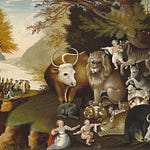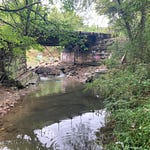There is a place in a forested park near my home, on the lower side along the creek, where my family likes to spread a blanket or hang a hammock in the nearby trees. We love the water and the life it feeds. It is a good place to sit and be and watch. Once along this creek we found the iridescent wings of a Great Purple Hairstreak butterfly; another time we discovered a salamander, swimming among the rocks. There are always plenty of birds and dragonflies and water bugs moving about.
Beside the creek, on the opposite bank, there is a Black Willow tree that hosts Yellow Warblers each spring. In summer, its leaves are food for the caterpillars of the Eastern Tiger Swallow-tail. And in the winter, it offers a perch to Goldfinches. The Black Willow is a native tree in Arkansas, common along creek and riverbeds. It grows quickly and helps control erosion along the banks. The willow’s wood is useful for a variety of purposes from making artificial limbs to baseball bats, and the pollen from its flowers is known as a source for particularly delicious honey. It is a tree full of life and healing.
On a recent visit to the creek, I noticed that this Black Willow had been cut to a stump of a couple of feet. I don’t know why, but for some reason the parks department decided to remove the tree. I doubt that as a result anyone is sporting a new limb or that a child has a new bat to use on the softball fields across the street. It was cut, hauled off, and likely turned to mulch. Despite the waste, however, I was glad to see that the willow was on its way back, not ready to accept its death. From the stump there are now several new trunks developing, working back up toward the sky. It is hard to kill a willow like this, for its true life is beneath the ground.
In the final chapter of the book of Revelation, we find a description of a river and a tree growing on either side of it. As I imagine the scene, I think of a willow like the one in the park. And that image is strengthened for me by the way John of Patmos, the author of the Apocalypse, describes this Tree of Life.
We have different ways we talk about trees. Go camping in a National Forest and we might remark about of the beautiful trees around us. Get a logging contract for that same forest and we’d talk about the timber. Biblical Greek is no different. Dendron is the word for tree, the kind you might see camping, but the word xulon—that meant timber or lumber. And strangely it is xulon that is the word used in Revelation for the tree beside the river. What we read as “the tree of life” could more literally be translated as “the timber of life.” Not quite the same ring to it, but it is an accurate rendering.
It is hard to know, of course, what John meant to say through this choice of words, but I think we have some license to believe using xulon rather than dendron was important to him. Revelation is a poetic book where word choices matter and carry a lot of meaning. Maybe John wants us to understand that this tree is not just any tree. Maybe he’s hinting that the tree of life is the cross resurrected.[1]
It may seem strange to us to think of the cross as a tree, but in the New Testament Luke, Paul, and Peter all refer to it that way. Christ was “hung on a tree” they tell us and in every case they use the word xulon. In this use, they are providing us with a different image of what the cross is—not merely a source of death, but also a bridge to life.
Historically, and across many cultures, trees have long worked as symbolic links between the realms below and above. They are rooted firmly in the ground, connected to the depths beneath the surface, and yet they can tower into the sky. The cross, John seems to be saying, is just that kind of bridge. It is the tree that provides the way by which God finally brings earth to heaven and heaven to earth. In this image, heaven isn’t some distant spiritual realm, but a reality that comes among us, renewing all things. God comes down, making God’s home among the finite, embodied creatures of earth. And all creation once again becomes God’s temple.
At the center of all this new reality is a tree that was once dead. Yet this tree now lives, because like Christ who made it meaningful, it has a deeper source of life. Christ’s life was not an independent reality that could be done away with according to the whims of an Empire. He was connected to the source of all life—God’s holy breath that works among the roots and brings resurrection to what once seemed lost. The invitation to us, is to also live from those depths. Heaven and earth have not yet been renewed, creation still groans with longing, but like a tree that grows deeper into the ground over the winter, we are invited to root ourselves in the life of God. It is that life that can bring us back from whatever storm may batter us or whoever tries to cut us down.
How do we live into this now, joining in the power of the Cross-Tree Life? The willow along the stream bank has many roots, some large, some small—all entwined and connected to the roots of other plants, a whole household of life beneath the surface. It is hard to grow without community and there is little hope of renewal without it. True community is not found in the mirrored halls of online life, it cannot be mediated by screens. Community exists in the embodied creaturely presence of those gathered, sharing breath and food. It takes patience and work to enter that sharing. We must show up, engage and risk, give and receive. We make our worship together. The living of this common life is often imperfect, it would be much easier to receive some slick religious goods and services, rather than welcoming Christ’s life among us in a homemade faith. But if we keep going back to our roots, conspiring together in the Holy Breath that is our Advocate, then we will find our way.
It is a way most of all of prayer—the primary roots of all our lives. Prayer in common, in silence, in the morning and the evening and along our way. Prayers of quiet listening and reception, prayers of offering, prayers of asking and interceding. In our prayer we are linked even when we are not together because we are joined in God who dwells at the deepest regions of ourselves. It is in prayer, here and now in the mess and grit of life, that we can begin to welcome heaven into earth, and bring earth into heaven, living from the energy of God rather than our own limited power. Prayer is our rooting ourselves in the depths despite what happens along the surface. It will connect us to the life that brings not only survival, but resurrection whatever might come our way.
That Black Willow along the banks of the stream in the park will likely be cut again, but because it is rooted in a community of life, and lives from a source of growth beneath the surface, it will come back. And each time it does, it will put on leaves to feed caterpillars and flowers to make honey. It will make seeds and spread them. Already, there are many other willows growing along the stream, and they will keep growing long after there is a parks department or a city here. And one day, the tree of which it is an image, will come and be a source of healing for the nations—the cross that joined heaven and earth, and turned death toward resurrection.
[1] The possible reference to the cross by the use of xulon was first suggested to me by Wes Howard-Brook. His “Radical Bible” series on YouTube is well worth watching.















Share this post